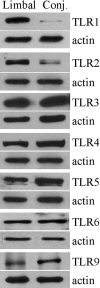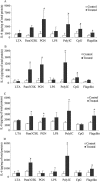Expression of toll-like receptors in human limbal and conjunctival epithelial cells
- PMID: 17615542
- PMCID: PMC2768757
Expression of toll-like receptors in human limbal and conjunctival epithelial cells
Abstract
Purpose: To determine the expression and function of toll-like receptors (TLRs) in human conjunctival, limbal and corneal epithelial cells.
Methods: Expression of TLRs was examined by real-time polymerase chain reaction, immunohistochemistry, and western blot analysis in human conjunctival, corneal and limbal epithelial cells and tissues. Ligand-stimulated nuclear factor kappaB activation; interleukin 6 and interleukin 8 protein secretion was measured in the cultured conjunctival and limbal epithelial cells by ELISA analysis.
Results: Expression of TLR1, 2, 3, 5, and 6 was found in all conjunctival and limbal epithelial cell samples analyzed by real time PCR and western blot. TLR4 and TLR9 transcripts were undetectable in some samples by real-time PCR. TLR7, 8 and 10 transcripts were not detected by real time PCR in any of the samples tested. TLR1, 2, 3, 4, and 5 proteins were found in conjunctival, limbal and corneal epithelium by immunohistochemistry. Cultured conjunctival epithelial cells expressed significantly lower levels of TLRs than uncultured conjunctival cells obtained by applying nitrocellulose paper to the bulbar conjunctival surface. Cultured limbal and conjunctival cells responded to stimulation by polyriboinosinic polyribocytidylic acid (poly[I:C]), palmitoyl-3-cysteine-serine-lysine-4 (Pam3CSK) and flagellin with increased secretion of IL-6 and IL-8 and the activation of NFkappaB. Peptidoglycans (PGN) and CpG DNA caused increased NFkappaB activity; however, only conjunctival epithelial cells showed increased cytokine secretion. Lipoteichoic acid (LTA) or lipopolysacchride (LPS) did not change cytokine secretion or NFkappaB levels in either cell type.
Conclusions: The TLRs found in human conjunctival and limbal epithelial cells provide a basis for responses to many common ocular pathogens. Although the mRNA and protein for TLR4 and TLR2 was found, neither conjunctival or limbal cells in culture responded to LPS or LTA stimulation.
Figures




Similar articles
-
Expression and function of muscarinic receptor subtypes on human cornea and conjunctiva.Invest Ophthalmol Vis Sci. 2007 Jul;48(7):2987-96. doi: 10.1167/iovs.06-0880. Invest Ophthalmol Vis Sci. 2007. PMID: 17591863
-
LBP and CD14 secreted in tears by the lacrimal glands modulate the LPS response of corneal epithelial cells.Invest Ophthalmol Vis Sci. 2005 Nov;46(11):4235-44. doi: 10.1167/iovs.05-0543. Invest Ophthalmol Vis Sci. 2005. PMID: 16249503
-
[The expression and functionality of Toll-like receptors in human corneal epithelium and tolerated human corneal epithelial cell line].Zhonghua Yi Xue Za Zhi. 2005 Aug 24;85(32):2269-73. Zhonghua Yi Xue Za Zhi. 2005. PMID: 16321207 Chinese.
-
Ocular surface inflammation mediated by innate immunity.Eye Contact Lens. 2010 Sep;36(5):269-81. doi: 10.1097/ICL.0b013e3181ee8971. Eye Contact Lens. 2010. PMID: 20703156 Review.
-
Nuclear Factor-κB: central regulator in ocular surface inflammation and diseases.Ocul Surf. 2012 Jul;10(3):137-48. doi: 10.1016/j.jtos.2012.04.001. Epub 2012 Apr 30. Ocul Surf. 2012. PMID: 22814642 Review.
Cited by
-
Conjunctival Goblet Cell Responses to TLR5 Engagement Promote Activation of Local Antigen-Presenting Cells.Front Immunol. 2021 Aug 9;12:716939. doi: 10.3389/fimmu.2021.716939. eCollection 2021. Front Immunol. 2021. PMID: 34434198 Free PMC article.
-
Neither non-toxigenic Staphylococcus aureus nor commensal S. epidermidi activates NLRP3 inflammasomes in human conjunctival goblet cells.BMJ Open Ophthalmol. 2017 Nov 16;2(1):e000101. doi: 10.1136/bmjophth-2017-000101. eCollection 2017. BMJ Open Ophthalmol. 2017. PMID: 29354725 Free PMC article.
-
Toll-like receptor-4 expression and oxidative stress in ocular rosacea.Mol Vis. 2023 Dec 26;29:357-364. eCollection 2023. Mol Vis. 2023. PMID: 38577560 Free PMC article.
-
Selecting Appropriate Reference Genes for Quantitative Real-Time Polymerase Chain Reaction Studies in Isolated and Cultured Ocular Surface Epithelia.Sci Rep. 2019 Dec 23;9(1):19631. doi: 10.1038/s41598-019-56054-1. Sci Rep. 2019. PMID: 31873107 Free PMC article.
-
S100A expression in normal corneal-limbal epithelial cells and ocular surface squamous cell carcinoma tissue.Mol Vis. 2011;17:2263-71. Epub 2011 Aug 20. Mol Vis. 2011. PMID: 21897749 Free PMC article.
References
-
- Lemaitre B, Nicolas E, Michaut L, Reichhart JM, Hoffmann JA. The dorsoventral regulatory gene cassette spatzle/Toll/cactus controls the potent antifungal response in Drosophila adults. Cell. 1996;86:973–83. - PubMed
-
- Aderem A, Ulevitch RJ. Toll-like receptors in the induction of the innate immune response. Nature. 2000;406:782–7. - PubMed
-
- Hayashi F, Smith KD, Ozinsky A, Hawn TR, Yi EC, Goodlett DR, Eng JK, Akira S, Underhill DM, Aderem A. The innate immune response to bacterial flagellin is mediated by Toll-like receptor 5. Nature. 2001;410:1099–103. - PubMed
-
- Miyake K. Endotoxin recognition molecules, Toll-like receptor 4-MD-2. Semin Immunol. 2004;16:11–6. - PubMed
Publication types
MeSH terms
Substances
LinkOut - more resources
Full Text Sources
